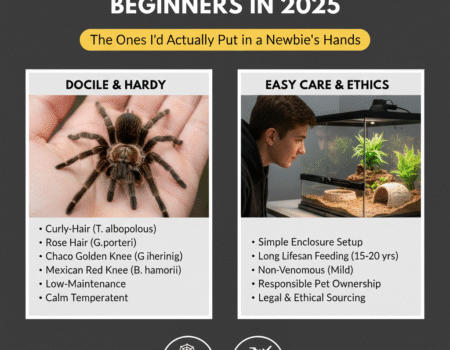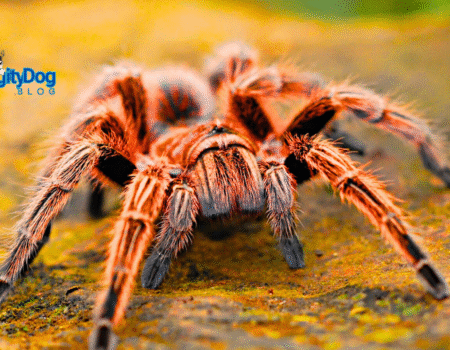Welcome to our guide on caring for your pet spider! Having a spider as a pet can be a unique and fascinating experience. Whether you’re a beginner or a seasoned spider keeper, providing the best care for your eight-legged friend is essential. In this article, we will share some essential tips to ensure the well-being and happiness of your pet spider.
Key Takeaways:
- Choose the right spider species that suits your needs and experience level.
- Create a safe and comfortable enclosure with appropriate materials and hiding spots.
- Feed your spider with pesticide-free insects once or twice a week.
- Provide access to fresh water without making the enclosure too humid.
- Handle your spider with caution and observe its behavior to understand its needs.
Choosing the Right Spider for Beginners
If you’re a beginner, it’s important to choose a spider that is easy to care for. Tarantulas are a popular option, but not all species are suitable for beginners. Some tarantulas require higher maintenance and are more likely to bite. Other good options for beginners include wolf spiders, jumping spiders, and grass spiders. These spiders are generally docile and easy to handle.
When starting out with a pet spider, it’s essential to handle a species that matches your level of experience and comfort. Tarantulas are known for their unique appearance and intriguing behavior, making them a popular choice for many beginners. However, they can vary in temperament and require specific care requirements. Some tarantula species may have specialized needs or may not tolerate handling as well as others. Therefore, it’s crucial to research and identify the best pet spider for your own circumstances.
In addition to tarantulas, other spider species are suitable for beginners. Wolf spiders are commonly found in North America and are known for their excellent hunting skills and agility. They have a relatively calm temperament and are less likely to bite unless provoked.
| Spider Species | Characteristic |
|---|---|
| Tarantulas | Varied temperament, maintenance requirements, and handling tolerance |
| Wolf Spiders | Docile and less likely to bite |
| Jumping Spiders | Active and visually striking, with limited handling tolerance |
| Grass Spiders | Prolific web-spinners and relatively easy to care for |
Jumping spiders are another fascinating group of spiders that captivate beginner enthusiasts. They are known for their excellent vision and ability to jump long distances, which adds an interactive aspect to their care. Although they are generally docile, they have a limited tolerance for handling and prefer interactive observation rather than hands-on contact. Grass spiders, on the other hand, are skilled web-spinners and may be more suitable for those who enjoy observing spiders’ natural behavior.
Remember, regardless of the species you choose, always prioritize your safety and the well-being of the spider. Respect their natural behaviors and create an environment that meets their specific needs. Whether you opt for a tarantula, a wolf spider, a jumping spider, or a grass spider, they are all fascinating creatures that can bring joy to your life as you embark on your pet spider-keeping journey.
Buying or Catching a Spider
Once you’ve decided on the type of spider you want, you have the option to either buy one or catch one in the wild. You can find many types of spiders for sale at pet stores, with tarantulas being a common choice. It’s important to specify whether you plan to breed your spider and the age you prefer. If you choose to catch a spider in the wild, make sure you know how to identify the different species in your area and handle them safely.
If you opt to buy a pet spider, visit reputable pet stores or explore trusted online sellers that specialize in exotic pets. They often offer a wide selection of different spider species, ranging from docile tarantulas to the more active jumping spiders. Before purchasing, ensure that the seller provides detailed information about the spider’s species, temperament, and care requirements. It’s important to choose a spider that suits your experience level and meets your expectations as a pet owner.
If you’re interested in the adventure of catching a spider, it can be an exciting way to acquire your pet. However, it’s crucial to educate yourself about the various species in your area and their behavior. Research the types of spiders that are commonly found in your region and learn how to identify them accurately. Additionally, be aware of any specific regulations or permits required for catching spiders in your location.
When catching a spider, always prioritize safety. Make sure to handle the spider carefully to avoid harm to yourself or the spider. The use of appropriate tools like a container and soft brush can assist in gently guiding the spider into its temporary enclosure. Remember, it’s best to release spiders back into their natural habitat after observing or studying them for a short period, ensuring their well-being and the preservation of their ecosystem.
| Pros of Buying a Pet Spider | Cons of Buying a Pet Spider |
|---|---|
| Wide variety of species and options to choose from | May be more expensive compared to catching one in the wild |
| Reliable source of information from pet store experts | Shipping risks if purchasing online |
| Opportunity to select the desired age and sex of the spider | May be limited availability for certain rare species |
Setting Up the Spider’s Enclosure
Creating a safe and comfortable enclosure is crucial for your pet spider. Whether you have a tarantula or a smaller species, providing the right environment is essential for its well-being and longevity.
For larger spiders like tarantulas, an aquarium or terrarium is an ideal ready-made habitat. Make sure the enclosure is spacious enough for the spider to move around comfortably. Choose a size that allows the spider to fully extend its legs without touching the sides. This will help prevent injury and ensure a stress-free living space.
When setting up the enclosure, it’s important to mimic the spider’s natural environment. Include materials such as leaves, dirt, rocks, and hiding spots. These natural elements provide a sense of security and allow the spider to engage in its instinctive behaviors.
If you have a smaller spider, you can create a homemade enclosure using a glass jar. Ensure the jar has proper ventilation to maintain airflow and prevent humidity build-up. Line the bottom of the jar with substrate like potting soil or coconut fiber, creating a suitable habitat for the spider.
Remember to regularly clean the enclosure to maintain a hygienic environment for your pet spider. Remove any uneaten prey, shed skin, or debris to prevent the growth of harmful bacteria or parasites.
Materials to Include in the Enclosure:
- Leaves: Provide a hiding spot and a sense of security for the spider.
- Dirt: Mimic the natural substrate where spiders burrow.
- Rocks: Create climbing opportunities and provide texture to the enclosure.
- Hiding Spots: Offer caves or hollowed-out objects for sheltering.
Remember that each spider species may have specific preferences, so research the needs of your particular pet spider type to create the most suitable enclosure.
Creating an appropriate enclosure for your pet spider is the first step to ensuring its well-being and happiness. It’s important to provide a safe, spacious, and stimulating environment that resembles its natural habitat. By following these tips, you can create a comfortable and engaging enclosure that promotes your pet spider’s overall health and enjoyment.
Feeding Your Spider
Spiders, being carnivorous creatures, have a unique diet that consists primarily of insects. As responsible spider owners, it’s essential to provide our eight-legged friends with regular meals to ensure their health and well-being.
Frequency of Feeding:
We recommend feeding your pet spider once or twice a week. It’s important not to overfeed them as this can lead to abdominal issues and other health problems. Remember, in the wild, spiders aren’t guaranteed a meal every day.
Sourcing Food:
You have two options when it comes to feeding your spider: hunting for insects or purchasing them from pet stores. If you choose to hunt for insects, make sure they are pesticide-free to avoid any harm to your pet. Alternatively, you can find a variety of live insects suitable for spider consumption at pet stores.
Once you’ve acquired the prey, it’s time to serve it to your spider. You can either release the live insect into the enclosure or use feeding tongs to place it within reach of your spider. The latter method allows for more control and minimizes the chances of potential harm to your pet.
Note: Some spider species prefer to ambush their prey, while others actively hunt and chase. Observing your spider’s behavior during feeding can be an exciting experience.
Post-Feeding Precautions:
After your spider has enjoyed its meal, it’s crucial to seal the enclosure properly. This step is especially important for tarantulas, which are known for their skilled escape abilities. Ensure that all gaps and openings are secure to prevent any accidental escapes.
| Feeding Your Spider: | Important Considerations: |
|---|---|
| Frequency: | Once or twice a week, avoiding overfeeding. |
| Food Source: | Hunting for pesticide-free insects or purchasing them from pet stores. |
| Feeding Method: | Release live insect into the enclosure or use feeding tongs. |
| Post-Feeding: | Seal the enclosure securely to prevent escapes. |
Feeding is a vital part of caring for your pet spider. By providing them with a proper diet and ensuring their enclosure is secure after meals, you’ll be promoting their overall health and happiness.
Providing Water for Your Spider
In addition to food, spiders also need access to fresh water. Ensuring that your pet spider has an adequate water supply is essential for its well-being. Here are some tips on providing water for your spider in its enclosure.
1. Water Bowl
If you have smaller spiders, you can use a small plastic bottle cap as a water bowl. Place the cap inside the enclosure, making sure it is easily accessible for your spider. This provides a convenient and shallow source of water for your pet.
2. Small Bowl of Water
If you have more space in the enclosure, you can provide a small bowl of water. This allows your spider to immerse itself partially if desired. Make sure to choose a bowl that is shallow and stable to prevent any accidents.
3. Damp Webbing
Spiders may also drink water off damp webbing. You can lightly mist certain areas of the enclosure, such as the corners or decorations, to create a humid environment. This method mimics the natural dew or rain that spiders encounter in the wild.
It’s important to note that while providing water, you should be cautious not to make the enclosure too humid. Spiders generally do not thrive in high humidity environments. Strike a balance by maintaining a suitable level of moisture without creating excessive humidity.
Remember to regularly refill the water container to ensure your spider has access to clean and fresh water at all times. Additionally, monitor the water source to ensure it remains free of any debris or contaminants that could harm your pet.
| Water Source | Advantages |
|---|---|
| Plastic bottle cap | – Easy to access – Shallow water source |
| Small bowl of water | – Allows partial immersion – Provides a larger water source |
| Damp webbing | – Mimics natural dew or rain – Provides hydration while minimizing humidity |
Handling Your Spider
When it comes to handling your pet spider, it’s crucial to proceed with caution, especially because some species have the potential to bite. While it’s generally best to avoid handling smaller and fragile spiders, sturdier species like tarantulas can be held carefully with proper technique. Here are some helpful tips for safely handling your spider:
- Use tweezers or gentle hand placement: To lift the spider, use tweezers or carefully place your hand near its leg and gently lift it. Avoid gripping or squeezing the spider to prevent any harm.
- Place it in your palm: Once you have successfully lifted the spider, place it in your palm, ensuring it feels secure and supported. This way, you can observe and interact with your spider while minimizing any potential risks.
- Avoid letting it crawl all over your body: While it might be tempting to let your pet spider crawl around, it’s important to avoid this to prevent any risk of losing it or accidental harm.
- Minimize handling: It’s important to remember that tarantulas and most pet spiders do not need to be handled. Handling can cause stress to the spider, and unnecessary interactions should be minimized.
By following these guidelines, you can safely handle your spider without putting yourself or your pet at risk. Remember, the well-being of your spider is the top priority, so always prioritize its comfort and safety.
If you’re unsure about handling your spider or have any concerns, it’s best to consult an expert or a veterinarian specializing in arachnid care for guidance specific to your spider’s species and needs.
Quote:
“Handling your spider with care is essential for their well-being. By following proper techniques, you can interact with your pet and observe their fascinating behaviors while ensuring their safety.”
Observing and Understanding Your Spider
Spiders are fascinating creatures, and observing their behavior can be a rewarding experience. By closely watching our pet spiders, we can gain insights into their eating habits, sleeping patterns, and overall activity levels. This section will guide you on how to observe and understand your spider, allowing you to build a better understanding of its individual needs and preferences.
To effectively observe your pet spider, we recommend setting aside specific times for focused observation. Find a quiet and comfortable spot near its enclosure, where you can have a clear view without disturbing the spider’s natural habitat. Bring a notebook or maintain a digital record to document your observations and track any patterns or changes.
Below are a few key aspects to observe when studying your pet spider:
- Eating Habits: Pay attention to the spider’s feeding behavior. Note the frequency and amount of food it consumes during each feeding session. Observe how it responds to prey items and how it maneuvers its body during the feeding process.
- Sleeping Patterns: Spiders have distinct rest periods and may spend extended periods in a motionless state. Observe when your spider is most active and when it retreats to a resting position. Note any changes in its activity levels over time.
- Webbing Behavior: Spiders often create intricate webs used for catching prey and creating shelter. Observe how your spider constructs its web and the locations it chooses for web placement. Take note of any variations in web structure or patterns over time.
- Movement and Exploration: Monitor how your spider moves within its enclosure. Observe its exploratory behaviors, such as climbing, jumping, or burrowing. Note any specific areas or objects it prefers to interact with.
Tip: When observing your spider, be patient and avoid sudden movements or loud noises, as they can startle or stress the spider.
Remember, each spider is unique, and careful observation is crucial to understanding its individual needs and behaviors. By documenting your spider’s habits over time, you’ll be able to identify any potential concerns, ensure its well-being, and provide a fulfilling pet spider care experience.
| Aspect of Observation | What to Observe |
|---|---|
| Eating Habits | Frequency and amount of food consumed, response to prey items, feeding maneuvers |
| Sleeping Patterns | Resting periods, activity levels, changes in sleep patterns |
| Webbing Behavior | Web construction, locations of web placement, changes in web structure |
| Movement and Exploration | Movement patterns, climbing, jumping, burrowing, preferred interaction areas |
Creating a Suitable Environment for Your Spider
When it comes to caring for your pet spider, creating a suitable environment is essential for its well-being. Here are some key considerations:
Choose a Stable Surface
Select a stable surface for your spider’s enclosure to ensure its safety. Keep it away from potential hazards or accidental knocks that could harm your spider.
Provide Natural Room Lighting
Most pet spiders, such as tarantulas, do not require special heating or lighting systems. They can thrive with natural room lighting. However, it’s important to make sure the temperature doesn’t drop below 70 degrees Fahrenheit to maintain an optimal environment for your spider.
Prevent Accidental Escapes or Harm
Keep the enclosure away from household pets and young children to prevent any accidental escape or harm to the spider. Spiders can be delicate, and it’s crucial to create a safe space for them to thrive.
By following these guidelines, you can ensure that your pet spider has a suitable and secure environment to call home.
| Benefits | Considerations |
|---|---|
| Provides a safe and stable space for your spider | Avoid placing the enclosure near potential hazards |
| Allows natural room lighting for your spider | Monitor the temperature to prevent it from dropping too low |
| Prevents accidental escapes or harm to the spider | Keep the enclosure out of reach of household pets and young children |
Remember, a suitable environment is crucial for the overall well-being and happiness of your pet spider.
Conclusion
In conclusion, caring for a pet spider requires research and attention to their specific needs. It’s important to choose a spider species that suits your needs and experience level as a keeper. By providing an appropriate enclosure, regular feeding, and fresh water, you can ensure the well-being of your pet spider.
Handling your spider with care and observing its behavior are also crucial to its care. Remember, each spider is unique and understanding their individual needs will help you provide the best care for your eight-legged friend. With proper care and attention, a pet spider can make a fascinating and captivating addition to your home.
So, if you’re considering a spider as a pet, remember to do thorough research, create a suitable environment, and be attentive to their needs. With dedication and proper care, you can enjoy the rewarding experience of having a pet spider and provide them with a happy and fulfilling life.
FAQ
What are some suitable spider species for beginners?
Some suitable spider species for beginners include tarantulas, wolf spiders, jumping spiders, fishing spiders, and grass spiders. These spiders are generally docile and easy to handle.
Can I buy a pet spider?
Yes, you can purchase a pet spider from pet stores or reputable online sellers. Tarantulas are a common choice and are readily available for sale.
Can I catch a spider in the wild to keep as a pet?
Yes, you can catch a spider in the wild to keep as a pet. However, make sure to research the spiders in your area before catching one and know how to handle them safely.
What type of enclosure should I use for my pet spider?
For larger spiders like tarantulas, a ready-made habitat like an aquarium is suitable. For smaller spiders, a glass jar with proper ventilation and substrate can be used as a homemade enclosure.
What do pet spiders eat?
Pet spiders are carnivorous and feed on insects. You can hunt for insects to feed your spider or purchase them from pet stores. Ensure the prey insects are pesticide-free.
How often should I feed my pet spider?
Feed your spider once or twice a week, being careful not to overfeed as it can lead to abdominal issues.
How do I provide water for my pet spider?
For smaller spiders, you can use a small plastic bottle cap as a water bowl. If you have more space, provide a small bowl of water. Refill the water regularly to ensure your spider has access to clean water.
Can I handle my pet spider?
Some species of spiders can bite, so it’s important to handle your spider with caution. Sturdier species like tarantulas can be held carefully using tweezers or gentle hand placement. However, minimize handling to reduce stress on the spider.
How can I observe and understand my pet spider’s behavior?
Keep an eye on your spider to learn about its eating habits, sleeping patterns, and activity levels. Consider keeping a notebook to record its behaviors. Each spider is unique, and observing them will help you build a better understanding of their individual needs and preferences.
Do I need any special temperature or lighting for my pet spider?
Most pet spiders, like tarantulas, do not require special heating or lighting and can thrive with natural room lighting. However, ensure the temperature doesn’t drop below 70 degrees Fahrenheit.
What should I consider when creating a suitable environment for my pet spider?
Choose a stable surface for your spider’s enclosure, away from potential hazards or accidental knocks. Keep the enclosure away from household pets and young children to prevent any accidental escape or harm to the spider.










No Comment! Be the first one.